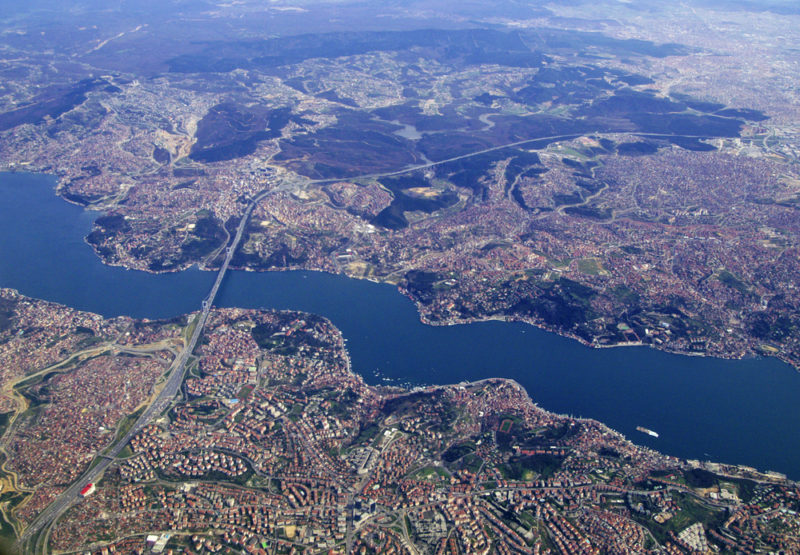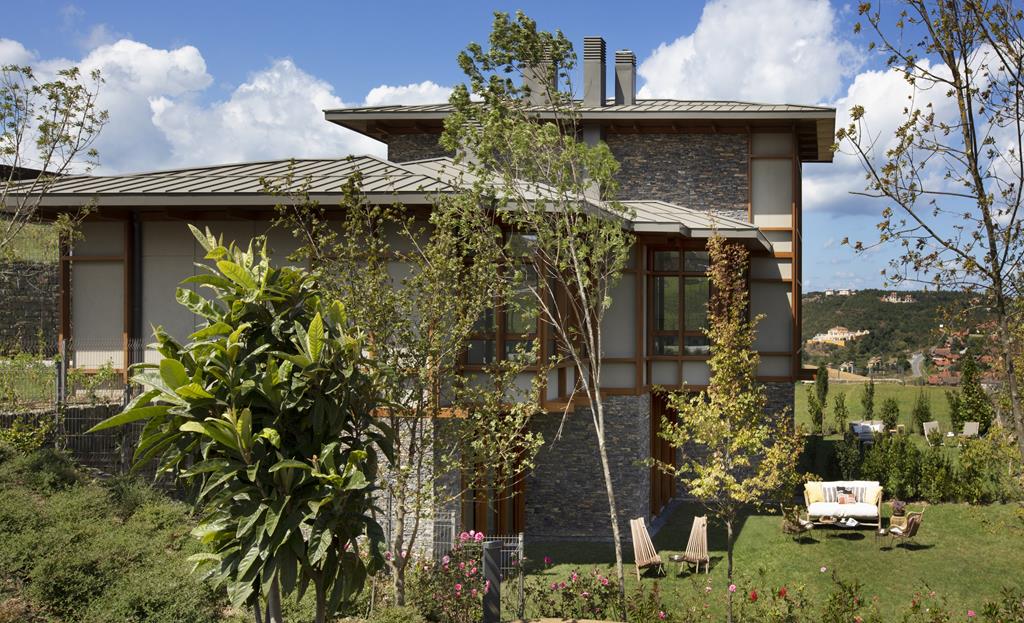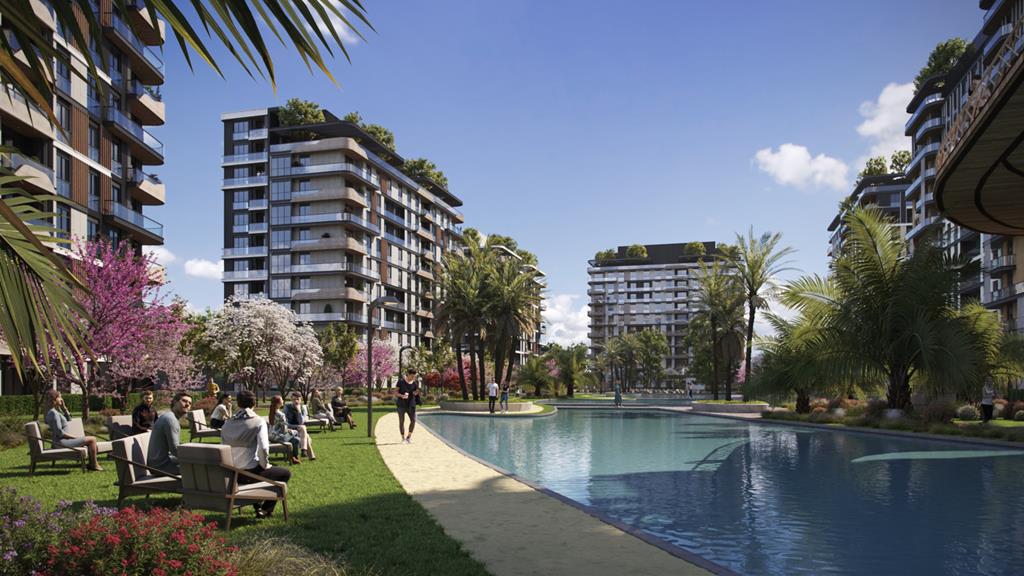Istanbul New Airport reflects Turkey’s commitment to progress. Symbolising the country’s economic and infrastructural prowess, that makes it a top hub for real estate investment, this structure is nothing short of spectacular.
Nestled between Europe and Asia, this architectural marvel is not merely an airport but also illustrates connectivity, seamlessly linking continents and cultures. Having replaced Ataturk airport in a groundbreaking ceremony and with plans to become the world’s biggest airport, with hundreds of international flights, this addition to Istanbul’s city centre has boosted the global city’s reputation.
The project tender was conceived to escalate the air traffic demands of Istanbul Atatürk Airport, which had outgrown the rapidly growing city. In 2013, the Turkish government proposed a new airport to address this issue and position Istanbul as a global aviation hub by making it one of the world’s busiest airports. The project aimed to transform Turkey into a centre of aviation. They are well on their way to achieving their global vision.
Istanbul New Airport and the Center of Aviation in Turkey
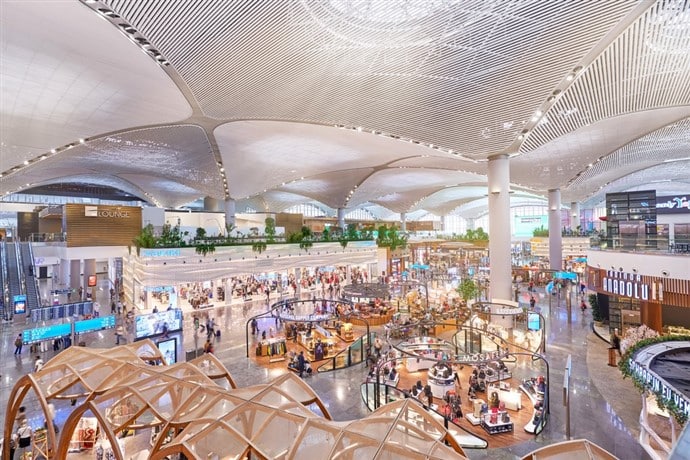
Where is Istanbul New Airport?
On the European side, Istanbul Airport is approximately 35 kilometres (22 miles) northwest of the city centre. Some sources say the airport is in the Black Sea region but officially belongs to the Marmara region of Turkey.
Design Philosophy
The architectural design blends modernity and cultural resonance. The airport was conceived to reflect Turkey’s rich history and serve as a gateway that welcomes travellers to historical significance. Inspired by the tulip – a symbolic flower in Turkish culture – the sprawling terminal is an awe-inspiring sight regarding scale and aesthetics. The terminal’s design captures the essence of Turkish heritage and prioritises functionality. Incorporating cutting-edge technology and sustainable practices further positions Istanbul Airport as a model for future airport construction.
Construction Challenges
Constructing Istanbul Airport was an ambitious undertaking, fraught with challenges that tested the resilience of the project team. The construction was unprecedented, involving the creation of Turkey’s largest airport terminal of 1.4 million square metres and the development of extensive runway and taxiway networks.
The site presented geological challenges that required innovative engineering solutions. One remarkable aspect of the construction process was implementing the hybrid bridge-building method for the main terminal. The result was efficient construction processes that adhered to strict timelines and met the deadline for the groundbreaking ceremony.
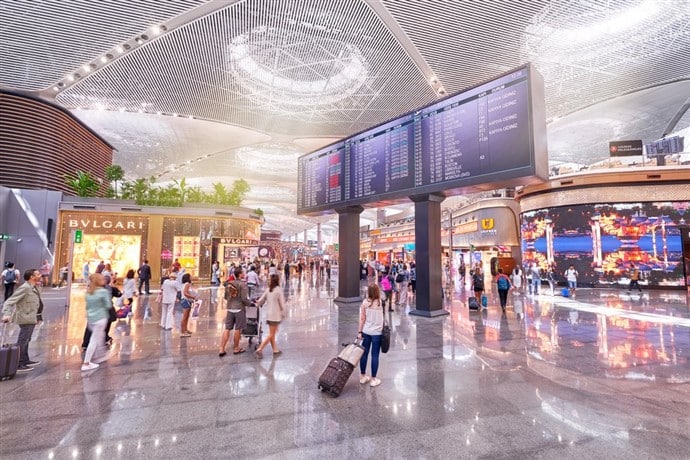
Facts and Figures
Size and Capacity: Istanbul Airport covers approximately 76.5 million square meters, making it one of the largest airports globally and popular with frequent flyers. The airport’s initial capacity is around 90 million passengers annually, with future expansion plans aiming to increase this capacity to 200 million.
Runways and Taxiways: The airport features three independent parallel runways, each 3,750 meters long, allowing simultaneous take-offs and landings. The extensive taxiway network includes rapid exit parallel taxiways, reducing aircraft taxi times and enhancing overall operational efficiency.
Operational Facilities and Amenities
Terminals, Airlines and Destinations: Istanbul Airport’s vast passenger terminal complex has multiple terminals to accommodate domestic and international flights. The terminals are designed for efficiency and seamless passenger experiences. The airport hosts various airlines, connecting passengers to domestic and international destinations. Passenger flights currently go to more than 350 destinations around the world.
Check-In, Lounges and Baggage Services: Expect modern and efficient check-in facilities, including self-service kiosks. Baggage services are available to ensure smooth handling and delivery, and there is also the baggage claim centre. Istanbul Airport features numerous lounges offering amenities for passengers travelling in various classes. These lounges often include comfortable seating, dining options, shower facilities, and business services. There are also convention centres for business travellers.
Shopping and Dining: The airport boasts extensive shops and dining outlets, ranging from luxury brands to local favourites. Free Wi-Fi is available throughout the airport, enabling passengers to stay connected during their journey. Charging stations are also strategically placed to ensure that travellers can recharge their electronic devices.
Transportation and Parking Services: Various transportation options are available for passengers from both terminal buildings. This includes city taxis, buses, private transfers, and car rental services into the city centre. Expect extensive parking facilities, including short-term and long-term parking options. Valet parking services are available.
Other Services: The airport has medical facilities to assist passengers in need, and passengers will find it family-friendly. Reflecting the region’s cultural diversity, Istanbul Airport has prayer rooms and mosque facilities for passengers and visitors to observe religious practices. The airport offers meeting rooms and conference facilities for business travellers. There is also an airport hotel and VIP and CIP (Commercially Important Persons) services for passengers who seek an elevated and personalised travel experience.

What Happened to Ataturk International Airport?
Istanbul Ataturk airport closed to commercial flights, and instead hosted cargo companies and also private jets. However, a big part has been sectioned off to build a green park. Istanbul’s Atatürk Airport City Park, the largest in Turkey and the world’s fifth-largest has sprawling grounds adorned with 145,300 newly planted trees across 13,000 meters (42,650 feet) of pathways.
Covering an expansive 2 million square meters, the former aviation hub-turned-public park offers serene escapes, providing respite from crowds, traffic, and noise. Construction of the park dubbed the “Green Corridor of Istanbul,” commenced in May 2022 and is now 95% complete.
Embracing a more environmentally friendly Istanbul, the park features zero-waste workshops, playgrounds, libraries, concert halls, soup kitchens, family amenities, and health activities for all ages. Additionally, the park houses an area representing the conquest of Istanbul, adorned with over 145,000 trees, including centuries-old olive, linden and plane trees.
The transformed airport grounds boast a 2.5-kilometre-long artificial stream named “Ab-ı Hayat Suyu,” flowing from south to north, along with observation terraces, picnic spots, relaxation areas, and bike and pedestrian paths lining the creek, enhancing tranquillity. The park, accessible via nine entrance points, also features greenhouses where citizens can enjoy organic products cultivated on-site.
Convenient Access to Istanbul City Center
As a bustling metropolis straddling two continents, Istanbul has long grappled with the challenges of urban mobility and convenient access to where people want to go. The opening of Istanbul International Airport in April 2019 marked transformative moments for air travel and the city’s entire transportation ecosystem. For convenient access, passengers have many choices.
Metro Connection: The Istanbul International Airport Metro, officially named the M11 line, stretches over 37 kilometres; the line connects to the Gayrettepe neighbourhood, a central hub in Istanbul. The metro line encompasses several vital stations, including Yeni Havalimanı, Gayrettepe, Kağıthane, Mecidiyeköy, Mahmutbey, and more, strategically linking to major residential and business areas. The metro line is designed for efficiency, with approximately 35 minutes to Gayrettepe.
Bus Services: Istanbul Grand Airport is well-connected to the city’s extensive bus network, providing additional flexibility for travellers. Buses cater to various routes, connecting to different neighbourhoods and districts in Istanbul. The presence of bus terminals at the airport facilitates the smooth operation of these services, contributing to efficiency of the public transportation system.
Taxis and Private Transfers: Taxis are available, but expect to pay hefty prices. Many people either book private or shared transfers before arriving on their flight. They get picked up outside the terminal building and taken straight to their door.
Transportation Hubs: Future developments include the creation of intermodal transportation hubs, connecting various modes of transportation seamlessly. These hubs facilitate easy transfers between the metro, buses, taxis, and other transportation options, offering passengers comprehensive and interconnected transit experiences.
Collaboration with Private Transportation Services: Recognising the evolving urban mobility landscape, Istanbul International Airport is exploring collaborations with private transportation services. Ride-sharing, electric scooters, and other innovative modes of transport may become integral components of the airport’s holistic transportation strategy.
Sabiha Gokcen International Airport – Istanbul’s Other Global Connection
Istanbul Airport services the European side, but if your visit is to the Asian side, it is worth looking at Sabiha Gökçen International Airport, the other major airport in the city’s dynamic transportation network. Named after Turkey’s first female combat pilot, Sabiha Gökçen, the airport has undergone remarkable growth and transformation since opening in 2001.
Sabiha Gökçen Airport was initially envisioned as an alternative to the congested Atatürk Airport, and officially commenced operations on January 8, 2001, marking significant milestones in Istanbul’s aviation history. The airport’s strategic location serves as a gateway for travellers from both domestic and international destinations.
The airport’s modern terminal complex reflects contemporary architectural design, offering efficient experiences for passengers. With sleek aesthetics and a functional layout, Sabiha Gökçen’s terminal can handle substantial volumes of domestic and international commercial flights. Beyond passenger services, Sabiha Gökçen Airport has established itself as crucial for cargo operations. Dedicated cargo facilities facilitate the movement of goods, supporting Istanbul’s role in the global economy.
Sabiha Gökçen Airport connects Istanbul to various domestic destinations while serving Turkish domestic flights. Notably, Sabiha Gökçen has carved niches for itself as a hub for low-cost carriers, attracting airlines like Pegasus that specialise in offering affordable travel options. This strategic positioning has increased accessibility and affordability for a broad spectrum of travellers.
Embracing technological advancements, Sabiha Gökçen has incorporated innovations such as self-check-in kiosks, mobile boarding passes, and advanced security systems. These features enhance operational efficiency and contribute to more secure passenger journeys. The airport technology is state of the art.
Gateway to Istanbul in Turkey
It would be easy to give full credit to Istanbul International Airport for increasing Istanbul’s global reputation. But the fact is, this city was already alpha, and the airport just cemented the power that the city held. Istanbul, the transcontinental metropolis, testifies to a combination of history, culture, and modernity. Often called the “City of Seven Hills” or the “Pearl of the Bosphorus,” Istanbul has evolved into an alpha city, rivalling the grandeur and influence of iconic European counterparts like Rome, Milan, and Paris.
One of Istanbul’s most compelling attributes is historical significance. The city’s heritage spans thousands of years, from Byzantium around 660 BCE to Constantinople by the Roman Emperor Constantine in 330 CE. Istanbul was the Eastern Roman Empire’s capital and later the Byzantine Empire before the Ottoman Turks conquered the city in 1453, leading to the establishment of the Ottoman Empire.
This layered history has bequeathed Istanbul with architectural marvels, such as the Hagia Sophia, Blue Mosque, and Topkapi Palace, which serve as cultural landmarks and powerful symbols of Istanbul’s historical grandeur.
Moreover, Istanbul has seamlessly integrated rich history into modern urban landscapes. The historic districts of Sultanahmet and Fatih coexist with modern neighbourhoods like Beyoglu, each contributing to Istanbul’s dynamic and diverse character. This ability to balance tradition and modernity is a hallmark of global alpha cities, where the past is not discarded but repurposed for progressive futures.
Geographically, Istanbul’s strategic location is pivotal to global prominence. The Bosphorus Strait, a natural waterway connecting the Black Sea to the Mediterranean, has been a conduit for goods and ideas, turning Istanbul into a vital economic and cultural hub. The city’s dual-continent status amplifies geopolitical importance and contributes to cosmopolitan atmospheres, attracting people and perspectives.
Economically, Istanbul is a powerhouse, driving Turkey’s economic engine and contributing significantly to the global market. The city is the country’s financial and commercial centre, hosting the Istanbul Stock Exchange and numerous multinational corporations.
The diverse economy spans finance, tourism, technology, and manufacturing, fostering innovation and ensuring robust economic landscapes. This economic vitality positions Istanbul alongside other alpha cities, where financial prowess defines everything.
Parallel to cultural vibrancy, Istanbul has become a beacon of education and intellectual pursuits. The city is home to prestigious universities, research institutions, and libraries, fostering academic excellence and contributing to the global pool of knowledge. Istanbul’s commitment to education positions it as a centre for intellectual exchange, drawing scholars and students worldwide.
The tourism sector further underscores Istanbul’s global allure. The city’s iconic landmarks, warm hospitality, and diverse cultural experiences attract tourists seeking blended history and modernity. The Grand Bazaar, Spice Bazaar, and historic sites of Sultanahmet draw millions of visitors annually, contributing significantly to the city’s economy. Istanbul’s popularity crosses global borders and offers immersive experiences that transcend time.
Overall, Istanbul’s journey from a historic crossroads to an alpha city is remarkable for adaptation, resilience, and progress. The city’s ability to seamlessly integrate rich history with forward-looking visions, strategic geographical positioning, economic strength, cultural vibrancy, educational excellence, and efficient infrastructure positions it on par with renowned European counterparts like Rome, Milan, and Paris. (More about Istanbul – Turkey.)
What are the Ten Busiest airports in the world?
Although, one can be in awe of Istanbul airport, it is yet to reach its goal as the busiest airport in the world. The following rank because of their annual passenger capacity.
Hartsfield–Jackson Atlanta: (ATL): Nestled in Atlanta, Georgia, Hartsfield–Jackson Atlanta stands as the undisputed leader in global aviation, with 93,699,630 passengers passing through. As the primary hub for domestic and international flights, Atlanta’s strategic location is the heartbeat of air travel.
Dallas Fort Worth (DFW): The Lone Star State hosts the second busiest airport globally. Located in Dallas–Fort Worth, Texas, DFW welcomed 73,362,946 passengers, an impressive increase of 17.5%.
Denver : (DEN): Amidst the scenic landscapes of Denver, Colorado stands the third busiest airport, handling roughly 69,286,461 passengers per year. DEN is a crucial gateway known for innovative design and sustainability.
O’Hare (ORD): Chicago, Illinois, hosts the fourth busiest airport worldwide. With passenger counts 68,340,619, ORD has experienced substantial increases of 26.5%. Renowned for connectivity and efficiency, O’Hare links the Midwest to international destinations.
Dubai (DXB): The United Arab Emirates boasts the 5th-busiest airport. In Garhoud, Dubai, DXB recorded 66,069,981 passengers, signalling an impressive increase of 23%.
Los Angeles (LAX): On the sun-kissed shores of California, Los Angeles secures the sixth spot. LAX remains a formidable force despite a slight decrease, welcoming 65,924,298 passengers. With a 37.3% increase, LAX remains a primary gateway between the United States and international destinations.
Istanbul Airport (IST): Turkey’s Istanbul Airport, the 7th-busiest airport in Arnavutkoy, hosted 64,289,107 passengers, an increase Y-O-Y of 73.8%. Istanbul Airport’s strategic location bridges the East and West.
Heathrow Airport (LHR): United Kingdom’s Heathrow Airport, situated in Hillingdon, London, secures the eighth position. With 61,614,508 passengers, LHR experienced increases of 217.7%.
Indira Gandhi (DEL): India’s capital, Delhi, hosts the ninth busiest airport. Handling 59,490,074 passengers, DEL witnessed an increase of 60.2%.
Charles de Gaulle Airport (CDG): France’s Charles de Gaulle Airport in Roissy-en-France, Île-de-France, claims the tenth position. With 57,474,033 passengers, CDG experienced notable increases of 119.4%.
Also About Turkey
Turkish Airlines: Turkish Airlines, established in 1933, has evolved into a globally recognised carrier renowned for its commitment to excellence, extensive route network, and exceptional in-flight services. Turkish Airlines operates the youngest and most modern fleets as Turkey’s national flag carrier. The airline’s hub, Istanbul International Airport, strategically positions it between Europe, Asia, Africa, and the Americas. With innovation and continuous expansion of global footprints, Turkish Airlines symbolises Turkey’s aviation prowess.
Seven Regions of Turkey: Turkey spans seven distinct geographical regions, each characterised by unique topography, climate, and cultural heritage. These seven regions collectively showcase the diversity and complexity that define Turkey’s multifaceted identity. This article looks at them all, from the beautiful Black Sea to the Marmara region, home to Istanbul new airport, turkey’s busiest air travel hub.
